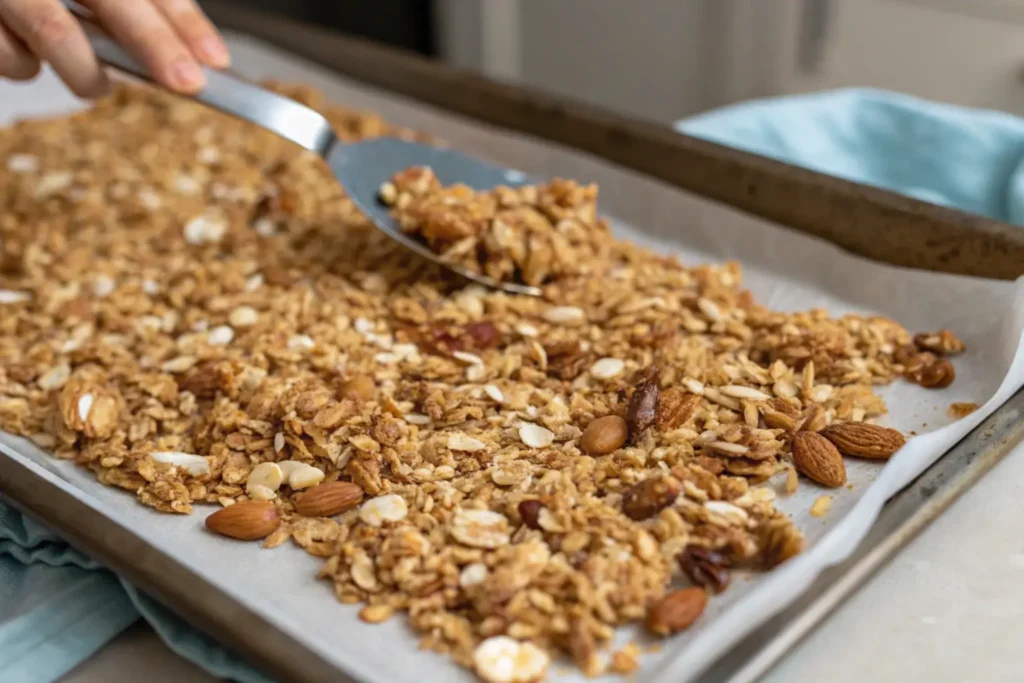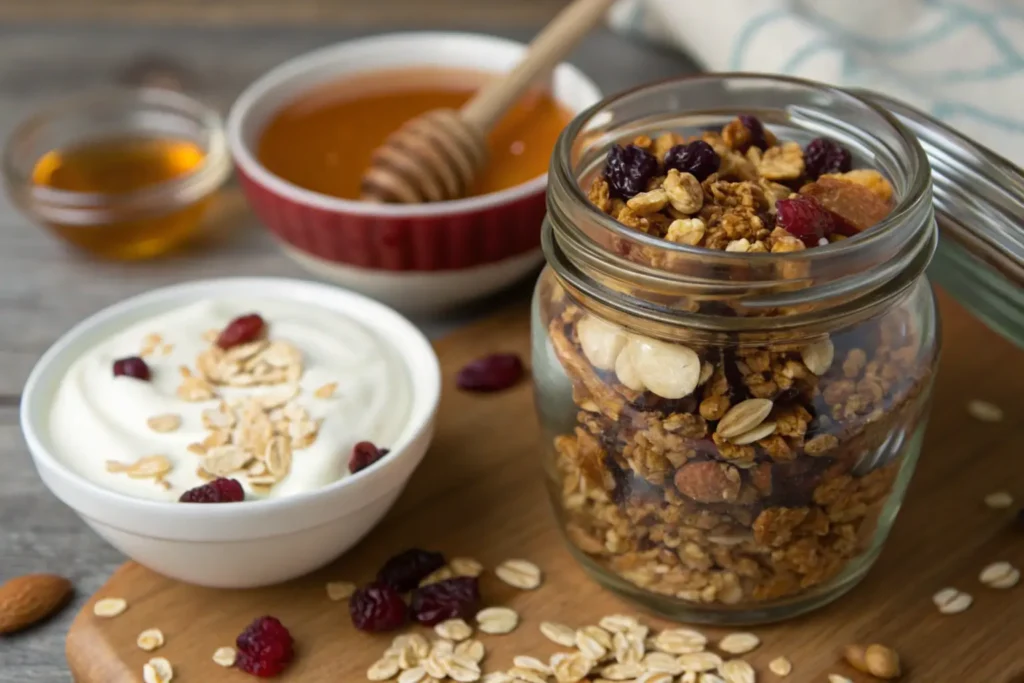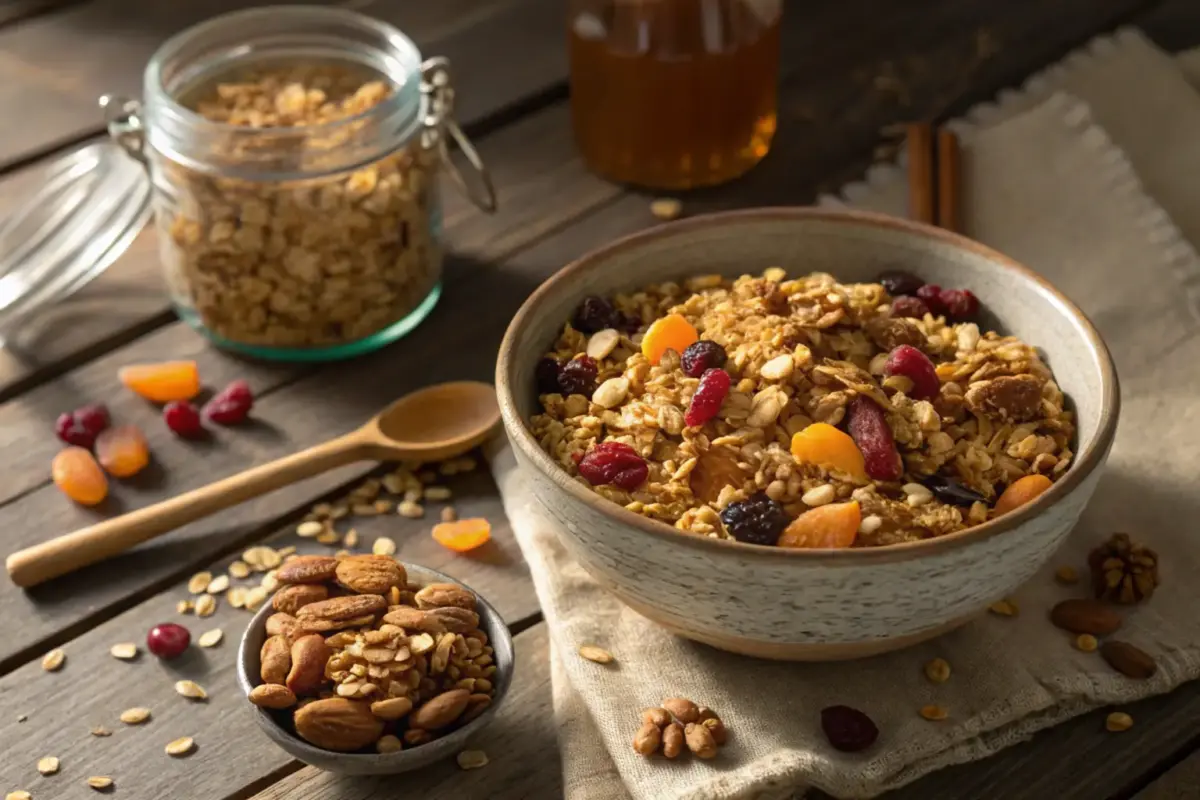Introduction
Let’s be honest—there’s nothing quite like homemade granola. It’s crunchy, sweet, and perfect on yogurt or just as a snack by itself. But every now and then, something goes wrong. You pull your tray of granola out of the oven, take a bite, and… bitterness. Total bummer, right? If you’ve ever wondered why your granola tastes off, you’re not alone. This guide breaks down the most common reasons for bitter-tasting granola and what you can do to nail that perfect batch every time.
Want to know the secrets to cohesive granola that doesn’t crumble? Check out What Ingredient Makes Granola Stick Together.
Understanding the Basics of Granola Making

What Is Granola and Its Components?
Granola is basically a mix of oats, nuts, seeds, sweeteners, and sometimes dried fruits or chocolate, all baked until golden and crisp. It’s simple enough, but every ingredient plays a key role in the final flavor. Oats form the base—mild and toasty when baked. Nuts and seeds bring crunch and richness, while sweeteners like honey or maple syrup add the sweetness that makes granola irresistible. Add-ins like coconut flakes or dried fruit can dial up the fun and flavor.
But here’s the thing: because granola has such simple ingredients, any small misstep can throw off the balance. A burnt nut or a too-heavy hand with the cocoa powder can make your granola go from yum to yikes in no time.
The Role of Ingredients in Flavors
Each ingredient in granola contributes to its overall taste, so understanding their roles can help you troubleshoot any problems. For example, nuts and seeds should add a buttery richness, but if they’re stale or overcooked, they can turn bitter. Sweeteners like honey or molasses bring depth, but they can also burn if your oven is too hot. Even the oil you use to coat the oats can change the flavor—choose a neutral oil like coconut or light olive oil to avoid bitterness.
Then there’s the balance between sweet, salty, and bitter flavors. A good granola walks a fine line, with each bite being just sweet enough without feeling cloying. Too much or too little of any one ingredient can tip the scales, and that’s when bitterness sneaks in.
Common Reasons for Bitter-Tasting Granola
Overcooking or Burning Ingredients
The most common culprit behind bitter granola? Overcooking. Granola needs to be baked low and slow—around 300°F (150°C)—to get that golden, toasty crunch. Crank up the heat to save time, and you’re asking for trouble. Oats, nuts, and sweeteners all burn easily, and when they do, they leave behind a bitter, charred flavor that’s impossible to mask.
Keep an eye on your granola while it’s baking. Stir it every 10-15 minutes to prevent hot spots from over-toasting certain areas. If you notice even a hint of burning, pull it out and let it cool—better slightly undercooked than bitter and ruined.
Using Rancid Nuts or Seeds
Nuts and seeds are essential in granola, but they can turn bitter if they’re not fresh. Ever grabbed a handful of walnuts and noticed they tasted “off”? That’s rancidity, and it happens when oils in the nuts break down over time. Unfortunately, once they’ve gone bad, there’s no saving them.
To avoid this, always store nuts and seeds in a cool, dry place. Better yet, keep them in the fridge or freezer if you don’t use them often. And before tossing them into your granola mix, give them a sniff and a taste. If they seem even a little funky, toss them out.
Bitter Sweeteners: Honey, Maple Syrup, or Molasses
Sweeteners are supposed to make granola, well, sweet. But if you’re using a sweetener like molasses or even certain kinds of honey, you might notice a slight bitterness. Molasses is naturally robust and can easily overpower the other flavors in your mix. Even maple syrup can taste burnt if it caramelizes too much in the oven.
Stick to mild sweeteners like clover honey or pure maple syrup, and don’t go overboard. A light drizzle is enough to coat the oats and nuts without turning sticky or overly sweet. If you’re experimenting with molasses or other bold flavors, start with a small amount and adjust based on taste.
Ingredient-Specific Issues
Improperly Toasted Nuts and Seeds
Nuts and seeds are the stars of granola—they’re crunchy, satisfying, and packed with flavor. But if they’re not toasted properly, they can easily bring an unpleasant bitterness to your mix. Toasting nuts and seeds is a delicate dance. Leave them underdone, and they’ll taste raw and bland. Overdo it, and their natural oils burn, creating that sharp, bitter taste.
The trick is to toast them lightly before mixing them with the oats. Spread them out evenly on a baking sheet, and pop them in the oven for about 5-7 minutes at 300°F. Check them often; they should smell nutty and just start to darken. Once they’re done, let them cool completely before adding them to your granola mix.
Dark Chocolate or Cocoa Powder Overload
Adding chocolate to granola sounds like a dream, right? But here’s the thing—too much dark chocolate or cocoa powder can backfire. Both ingredients naturally lean bitter, and when overused, they can overpower the sweeter and nuttier notes in your granola.
If you’re using chocolate chips, go for semi-sweet or milk chocolate for a more balanced flavor. If cocoa powder is your jam, keep it to a tablespoon or two per batch. And always mix cocoa powder with sweeteners like honey or sugar to offset its bitterness. You want your granola to taste indulgent, not like a bitter chocolate bar gone wrong.
The Problem with Bitter Oils
Oil is a key ingredient in granola—it helps coat the oats, creates that irresistible crunch, and locks in flavor. But not all oils are created equal. Some, like extra-virgin olive oil or certain nut oils, can have a naturally bitter edge that becomes more pronounced during baking.
For granola, stick with neutral-tasting oils like coconut oil, canola oil, or light olive oil. These options let the other ingredients shine without bringing any unwanted bitterness to the mix. And remember, you don’t need a ton of oil—just enough to lightly coat everything and help the oats crisp up.
Cooking Technique Problems
Uneven Baking or Mixing
If your granola is bitter in some bites but fine in others, uneven baking or mixing could be the culprit. When your ingredients aren’t spread out evenly on the baking sheet, certain spots can overcook while others stay underdone. Similarly, if you don’t mix the wet and dry ingredients thoroughly, you’ll end up with clumps of overly sweet or overly bitter bits.
To avoid this, use a large, rimmed baking sheet and spread the granola mixture in an even layer. Stir it every 10-15 minutes during baking to ensure everything cooks evenly. Trust me, it’s worth the extra effort to get that perfect crunch in every bite.
Excessive Use of Spices
Spices like cinnamon, nutmeg, and ginger can add amazing warmth and depth to granola. But too much of a good thing? Yep, you guessed it—bitterness. Overdoing it on the spices can overpower the sweetness and make your granola taste harsh.
A little goes a long way when it comes to spices. Stick to about a teaspoon of your favorite spice (or a combination) per batch. If you’re feeling adventurous and want to experiment with flavors, start small and adjust as needed. You can always sprinkle in more spice after baking if you feel it’s lacking.
The Impact of Oven Temperature
Baking granola might seem foolproof, but oven temperature plays a huge role in how your final product turns out. Too hot, and your granola can burn before it has a chance to crisp up. Too low, and you’ll end up with chewy, undercooked oats—and nobody wants that.
Stick to a consistent 300°F for the best results. If you’re in a rush and tempted to crank up the heat, resist the urge! High temperatures can cause sweeteners to caramelize too quickly, leading to burnt sugar and a bitter aftertaste. Take your time, and your granola will thank you with perfectly golden, crunchy goodness.
Solutions to Prevent Bitterness in Granola
Choosing Fresh Ingredients
It all starts with fresh, quality ingredients. Stale or rancid items, like nuts and seeds, are the number one reason people ask, why does my homemade granola taste bitter? Before you begin, check everything—sniff your nuts, taste your oats, and make sure your sweeteners don’t have an off flavor. Buying in small batches can help you avoid using ingredients past their prime.
For dried fruits, look for plump, fresh pieces rather than overly dry or tough ones. And don’t forget to use fresh spices—ground cinnamon or nutmeg loses its potency over time. Keeping your pantry staples fresh is a game-changer for granola that tastes great every time.
Balancing Sweetness and Bitterness
Great granola is all about balance. If your mix leans too bitter, counteract it with natural sweetness. A splash of honey, a drizzle of maple syrup, or a sprinkle of brown sugar can turn a bitter batch into a perfectly balanced one. Just be careful not to overdo it—too much sweetness can mask the toasty, nutty flavors you want to highlight.
Adding a pinch of salt can also work wonders. Salt isn’t just for savory dishes; it enhances sweet flavors and tones down bitterness. Wondering why does my homemade granola taste bitter? A lack of salt could be the answer. It’s the secret ingredient that makes granola taste vibrant and well-rounded.
Tips for Perfect Baking
Baking granola isn’t rocket science, but a little care goes a long way. Always preheat your oven and bake at a low, steady temperature—300°F is ideal. Spread your mixture evenly on the baking sheet, and give it a stir every 10-15 minutes to prevent uneven toasting.
Pay attention to color and smell. Your granola should be golden and fragrant when it’s done. If you’ve ever thought, why does my homemade granola taste bitter, it might be because you’re baking it at too high a temperature. Remember, granola will continue to crisp up as it cools, so don’t worry if it seems a little soft when you first take it out.
If crunch is your goal, but you struggle to achieve it, our guide on Why Homemade Granola is Not Crunchy offers actionable tips to get it just right.
Enhancing the Flavor Profile of Granola

Incorporating Natural Sweeteners
Natural sweeteners like honey, maple syrup, or agave are the MVPs of granola flavoring. They not only add sweetness but also create those delicious clumps everyone loves. For an extra twist, try using coconut sugar or date syrup. These options bring a caramel-like richness that complements the toasty oats and nuts.
If you’ve been wondering, why does my homemade granola taste bitter even after adding sweeteners, it could be the type you’re using. Stick to mild, natural options and mix your sweetener into your oil and spices before adding it to the dry ingredients. This ensures every bite is evenly coated with flavor, without any overly sweet or bitter patches.
Need inspiration for flavor combinations? Take a look at Trader Joe’s Vanilla Almond Granola Ingredients for ideas to elevate your homemade granola.
Adding a Hint of Citrus or Zest
If you’ve never tried adding citrus to your granola, you’re in for a treat. A touch of orange or lemon zest brightens up the flavors and adds a subtle tang that balances the richness of nuts and sweeteners. Just a teaspoon or two is enough to elevate the entire batch.
You can also experiment with dried citrus peels or a splash of orange juice in your mix. This is a great way to prevent people from asking why does my homemade granola taste bitter—it adds freshness and vibrancy that masks any harshness.
The Benefits of Salt in Balancing Flavors
Salt might not be the first thing you think of when making granola, but trust me, it’s a game-changer. A small pinch of salt enhances sweetness, rounds out bitterness, and makes every flavor pop. It’s like the glue that ties all the elements together.
Use fine sea salt or kosher salt for the best results. And remember, a little goes a long way. If you’re using salted nuts or seeds, adjust the amount of added salt to avoid overdoing it. It’s a simple step, but it can stop you from asking why does my homemade granola taste bitter in the first place.
FAQs
Why is granola bitter?
Granola can taste bitter for several reasons. Overcooking ingredients, using rancid nuts or seeds, or relying on bitter sweeteners like molasses can all contribute to the problem. Additionally, oils with strong flavors or over-toasting spices can make granola taste harsher than intended. If you’re asking why does my homemade granola taste bitter, check these factors first.
Why does my homemade granola taste burnt?
Granola tastes burnt when it’s cooked at too high a temperature or left in the oven too long. Sweeteners like honey and maple syrup caramelize quickly and can burn before the oats are fully toasted. Always bake at a low temperature (around 300°F) and keep a close eye on it, stirring frequently to prevent hot spots.
How to fix bland granola?
If your granola tastes bland, it likely needs more sweetness, salt, or spice. A drizzle of honey or maple syrup after baking can add sweetness, while a pinch of salt will bring out the flavors. Tossing in extras like dried fruits, coconut flakes, or a sprinkle of cinnamon can also boost the overall taste. This can help if you’ve ever asked why does my homemade granola taste bitter or bland at the same time.
What to avoid in granola?
When making granola, avoid using stale or rancid nuts and seeds, as they can make the entire batch taste bitter. Stay away from overly strong oils like extra-virgin olive oil, and be cautious with spices—too much can overwhelm the mix. Lastly, don’t bake at high temperatures, as this can lead to burnt, bitter granola.
Conclusion
Homemade granola is a labor of love, and when it’s done right, it’s unbeatable. By understanding the role of each ingredient and avoiding common pitfalls, you can create granola that’s perfectly balanced, flavorful, and free of bitterness. If you’ve ever wondered, why does my homemade granola taste bitter, now you know the reasons and the fixes. With these tips in your back pocket, you’ll be making granola that tastes amazing every time.

